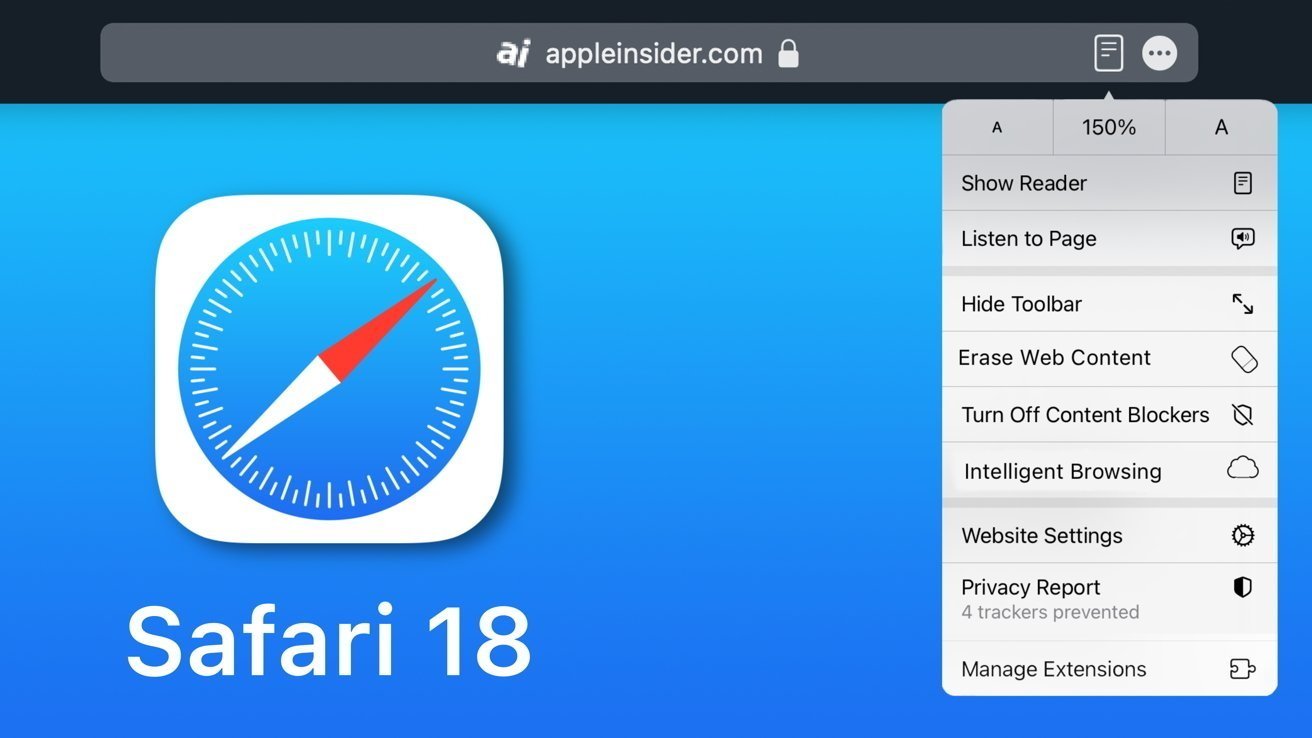How iOS 18's Web Eraser content-blocker morphed into a distraction-hiding tool
Apple has finally released its Web Eraser content blocker for Safari 18, albeit under the new name Distraction Control. Here's how the feature changed during development and why.

Apple has renamed its previously-unannounced Web Eraser content blocker to "Distraction Control"
With the fifth developer betas of iOS 18, iPadOS 18, and macOS Sequoia, Apple released a new Safari feature that helps users hide unwanted webpage content. Known as Distraction Control, it gives users a way of selecting and temporarily removing distracting page elements.
While the feature itself may be new, its arrival is not entirely unexpected. In April of 2024, AppleInsider exclusively revealed that Apple had been working on an in-house content blocker for Safari 18.
Now known as Distraction Control, the feature was internally referred to as Web Eraser during its development. Although Web Eraser was fully functional months before the initial beta of iOS 18.0, it was notably missing from Apple's initial round of developer betas and was not previewed at the company's annual WWDC in June 2024.
Though the exact reasons behind the feature's absence and apparent removal were not entirely clear, Apple's decision to delay and rebrand the feature was likely a response to the criticism Web Eraser garnered in the months ahead of WWDC.
Web Eraser - the controversy surrounding Apple's content blocker and its mysterious absence
Following AppleInsider's exclusive reveal of the feature and how it worked, major industry associations in the publishing and advertising sector sent out complaints to Apple about Web Eraser.

The UK's News Media Association is one of the organizations that sent out letters against Apple's planned Web Eraser feature - Image courtesy of NMA Ltd.
The UK's News Media Association and later a group of French publishers raised serious concerns about the Web Eraser. In its May complaint, the News Media Association said that it saw Web Eraser as an ad blocker, which it considered to be "a blunt instrument which frustrates the ability of content creators to sustainably fund their work."
The NMA chief, Owen Meredith, later went on to criticize Apple for developing Web Eraser without involvement from publishers, saying that this had "potentially significant consequences on how publishers' content is used or displayed on Apple devices."
On May 29, a group of French publishing associations sent out a letter to Apple CEO Tim Cook, alleging that Web Eraser could threaten 100,000 jobs in France. Their letter also said that the feature raised "numerous questions, particularly concerning legal and editorial responsibilities that Apple has not responded to."
So serious were the French publishers' concerns that they simultaneously sent out copies of their letter to multiple government officials. Among others, the letter was sent to the French Minister of Culture, Minister of Economy, and Minister of Digital Affairs, as well as to the European Commissioner for Internal Markets.
The uproar caused by Web Eraser's reveal appears to have had a significant impact on the feature itself and how Apple finally released it.
Why Apple decided to market its content-blocker as a distraction-hiding tool, and what was changed as a result
Based on the version of Distraction Control revealed on Monday, it appears as though Apple wanted to distance itself from Web Eraser and the negative connotations surrounding the feature.
-xl.jpg)
Distraction Control had a different icon and name in pre-release versions of iOS 18 and macOS Sequoia
As mentioned earlier, the company renamed Web Eraser to Distraction Control. In addition to this, the fifth developer beta of iOS 18 includes a new pop-up message that informs users of the feature's overall purpose, making it clear that it's not meant to block ads.
As in pre-release builds of Apple's operating systems, Distraction Control can be activated from the URL bar via the new page controls menu. Underneath Highlights, users will find an option labeled "Hide Distracting Items," with a crossed-out eye icon next to the feature name.
Originally, while the feature was still in development, this button simply read "Web Eraser," and had a stylized eraser as its icon.
Tapping the button for the first time will trigger an in-app pop-up message that explains how "hiding distracting items will not permanently remove ads and other content that update[s] frequently."

Hiding an item in Safari's Distraction Control for iOS 18
From this, it is apparent that the company wants to avoid any association with Web Eraser and the claims that it created an ad-blocker. Instead, the feature is presented in a way that implies its primary purpose is to hide unwanted or distracting page elements.
According to people familiar with the matter, this pop-up message was not present during the initial development period of Web Eraser. The pop-up message is seemingly a reaction to the controversy caused by Web Eraser's initial reveal and is likely an attempt to appease concerned publishers and industry associations.
Despite the rebrand and the new pop-up message, the feature maintains most of the functionality that it originally had in pre-release versions of Apple's operating systems. Distraction Control can still hide ads from the webpage currently on-screen, but the ads may reappear if the page is refreshed.
As the feature was never meant to be automatic, users still need to manually select the page element they would like to hide. With Distraction Control, users can hide images, text, and annoying banner ads, among other things.
When it comes to ads, pre-release versions of Web Eraser behaved differently from the publicly available Distraction Control. Internal versions of the feature had the ability to block the same page element across different web pages and maintained the users' choice of hidden elements even after the page was refreshed.
In practice, this means that earlier, pre-release versions of the feature were better at blocking advertisements. Apple appears to have scaled back the feature's ability to hide advertisements as a way of addressing ad-related concerns.
Relative to pre-release versions, Distraction Control features greatly improved animations. When the user selects an item and hides it, it disappears with a particle-type effect that early versions of Web Eraser didn't have.
macOS Sequoia received significant changes to the page controls menu, from which Web Eraser could be toggled. Unlike the current developer betas of macOS 15.0 and 15.1, pre-release versions featured a page menu with an iPad-like interface that had larger, rounded buttons.
Safari 18 also contains various other enhancements, such as the Highlights feature that provides useful page summaries along with an improved reader view. The latter two Safari features were both previewed during WWDC, meaning that Apple spent additional time working on its distraction-hiding tool.
Read on AppleInsider


Comments
Except that it absolutely was, and that got severe backlash from publishers. The feature is still there, but now the consumer/victim has to do something, and it's neutered so they can't remove ads anymore.
TANSTAAFL, folks.
For Apple to alter the products of other companies and for Apple to hit media companies while charging for Apple News and working on ads for TV+ is a legal quagmire.